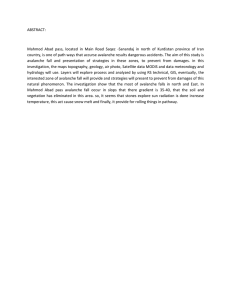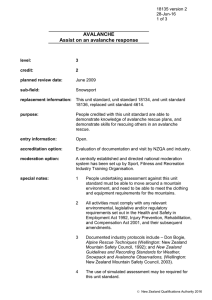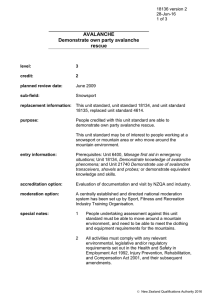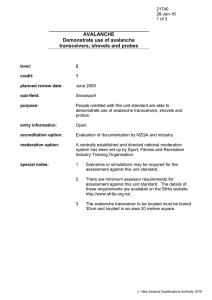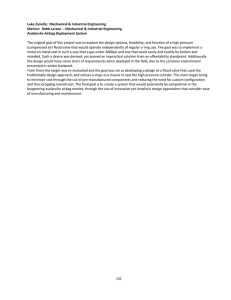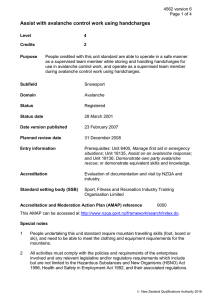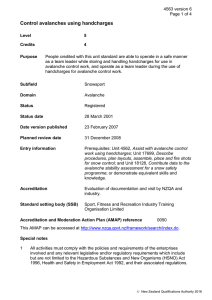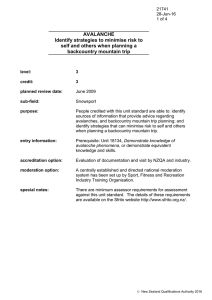AVALANCHE Record and communicate avalanche and weather observations
advertisement
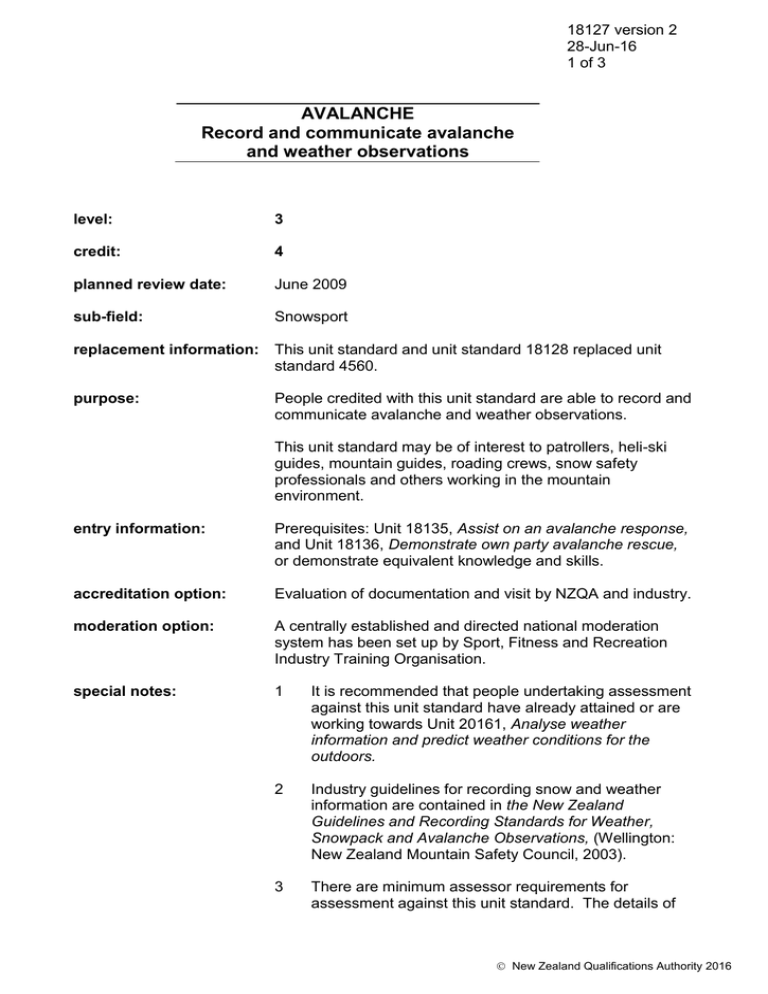
18127 version 2 28-Jun-16 1 of 3 AVALANCHE Record and communicate avalanche and weather observations level: 3 credit: 4 planned review date: June 2009 sub-field: Snowsport replacement information: This unit standard and unit standard 18128 replaced unit standard 4560. purpose: People credited with this unit standard are able to record and communicate avalanche and weather observations. This unit standard may be of interest to patrollers, heli-ski guides, mountain guides, roading crews, snow safety professionals and others working in the mountain environment. entry information: Prerequisites: Unit 18135, Assist on an avalanche response, and Unit 18136, Demonstrate own party avalanche rescue, or demonstrate equivalent knowledge and skills. accreditation option: Evaluation of documentation and visit by NZQA and industry. moderation option: A centrally established and directed national moderation system has been set up by Sport, Fitness and Recreation Industry Training Organisation. special notes: 1 It is recommended that people undertaking assessment against this unit standard have already attained or are working towards Unit 20161, Analyse weather information and predict weather conditions for the outdoors. 2 Industry guidelines for recording snow and weather information are contained in the New Zealand Guidelines and Recording Standards for Weather, Snowpack and Avalanche Observations, (Wellington: New Zealand Mountain Safety Council, 2003). 3 There are minimum assessor requirements for assessment against this unit standard. The details of New Zealand Qualifications Authority 2016 18127 version 2 28-Jun-16 2 of 3 AVALANCHE Record and communicate avalanche and weather observations these requirements are available on the Sfrito website http://www.sfrito.org.nz/. Elements and Performance Criteria element 1 Record and communicate avalanche and weather observations. Range: all data recorded according to industry guidelines and operational requirements. performance criteria 1.1 The purpose of recording weather and snow observations is described in basic terms. Range: 1.2 Snow and weather data are collected from standard study plot(s) and/or weather station(s), and the information documented at regular intervals. Range: 1.3 may include but is not limited to – cloud cover, air temperature, wind direction and speed, atmospheric pressure, relative humidity, precipitation type and intensity, rain, depth of snowfall and snowpack, weight and water equivalent and density of new snow, surface penetrability and condition. Avalanche occurrence is observed and information recorded. Range: 1.4 snow observations may include but are not limited to – snow penetrability, snow available for transport; weather observations may include but are not limited to – strong winds, sky condition, solar radiation influence, snowfall greater than 2cm per hour. date, time, trigger, avalanche path, type, identification name, size, moisture content, terminus, slab depth and width, elevation, slope angle, aspect. Avalanche and weather observations are communicated to supervisor, instructor or snow safety officer. New Zealand Qualifications Authority 2016 18127 version 2 28-Jun-16 3 of 3 AVALANCHE Record and communicate avalanche and weather observations Comments on this unit standard Please contact the Sport, Fitness and Recreation Industry Training Organisation info@sfrito.org.nz if you wish to suggest changes to the content of this unit standard. Please Note Providers must be accredited by the Qualifications Authority or a delegated interinstitutional body before they can register credits from assessment against unit standards or deliver courses of study leading to that assessment. Industry Training Organisations must be accredited by the Qualifications Authority before they can register credits from assessment against unit standards. Accredited providers and Industry Training Organisations assessing against unit standards must engage with the moderation system that applies to those standards. Accreditation requirements and an outline of the moderation system that applies to this standard are outlined in the Accreditation and Moderation Action Plan (AMAP). The AMAP also includes useful information about special requirements for providers wishing to develop education and training programmes, such as minimum qualifications for tutors and assessors, and special resource requirements. This unit standard is covered by AMAP 0050 which can be accessed at http://www.nzqa.govt.nz/site/framework/search.html. New Zealand Qualifications Authority 2016
